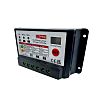Steca 12 V, 24 V 10A Solar Charge Controller
- RS Stock No.:
- 860-2871
- Mfr. Part No.:
- Solsum 10.10F
- Manufacturer:
- Steca
Discontinued product
Alternative
This product is not currently available. Here is our alternative recommendation.
Each
MYR410.36
- RS Stock No.:
- 860-2871
- Mfr. Part No.:
- Solsum 10.10F
- Manufacturer:
- Steca
- COO (Country of Origin):
- BG
Steca Solsum F
The Steca Solsum F-Line continues the huge success of one of the most used SHS controllers.
The circuit board is completely electronically protected and with the LED user interface it is easy to check the battery state of charge at any time. Large terminals guarantee a simple connection of solar panels, battery and load. The Steca Solsum F works on PWM as a low loss series controller
The circuit board is completely electronically protected and with the LED user interface it is easy to check the battery state of charge at any time. Large terminals guarantee a simple connection of solar panels, battery and load. The Steca Solsum F works on PWM as a low loss series controller
Voltage regulation
Automatic detection of voltage
PWM control
Multistage charging technology
Current compensated load disconnection
Automatic load reconnection
Temperature compensation
Common positive grounding or negative grounding on one terminal
Monthly maintenance charge
Automatic detection of voltage
PWM control
Multistage charging technology
Current compensated load disconnection
Automatic load reconnection
Temperature compensation
Common positive grounding or negative grounding on one terminal
Monthly maintenance charge
Displays
Multifunction LED display
Multi-coloured LED
4 LEDs show operating states ∼ for operation, state of charge, fault messages
Multi-coloured LED
4 LEDs show operating states ∼ for operation, state of charge, fault messages
Electronic protection functions
Overcharge protection
Deep discharge protection
Reverse polarity protection of module (≤36 V),load and battery
Automatic electronic fuse
Short circuit protection of load and module
Overvoltage protection at module input
Open circuit protection without battery
Reverse current protection at night
Overtemperature and overload protection
Load disconnection on battery overvoltage
Deep discharge protection
Reverse polarity protection of module (≤36 V),load and battery
Automatic electronic fuse
Short circuit protection of load and module
Overvoltage protection at module input
Open circuit protection without battery
Reverse current protection at night
Overtemperature and overload protection
Load disconnection on battery overvoltage
Solar Panels and Chargers
Solar “photovoltaic” panels use the power of the sun to generate electricity and can be used in a variety of applications from calculators to homes. They are most effective, versatile and cost saving in many commercial and leisure applications for charging 12/24V batteries.
Solar panels provide power through batteries at off grid and isolated locations and are widely used in critical telecommunications and telemetry applications. Solar panels enable rapid installation of equipment at remote sites, either temporary or permanent, avoiding the costs and inconvenience of grid connection. They are designed for very low maintenance and longevity.
Solar panels provide power through batteries at off grid and isolated locations and are widely used in critical telecommunications and telemetry applications. Solar panels enable rapid installation of equipment at remote sites, either temporary or permanent, avoiding the costs and inconvenience of grid connection. They are designed for very low maintenance and longevity.
How Much power?
The daily power production of a solar panel can be calculated by multiplying the panel’s peak power rating by between 0.5 and 6 depending on the time of year, angle and location. For example; an 80Watt solar panel produces a peak current of 4.55A.
Solar Installation
Solar panels are usually installed at a 55-65° angle for optimal wintertime performance. For a year round power supply solar panels can be combined with Wind chargers.
Solar panels can be connected in parallel to increase power and in series to increase voltage.
To complete the system deep cycle batteries, a voltage regulator and electrical cables are required to get up and running. A range of convenient mounting kits are available for pole or wall mounting.
Solar panels can be connected in parallel to increase power and in series to increase voltage.
To complete the system deep cycle batteries, a voltage regulator and electrical cables are required to get up and running. A range of convenient mounting kits are available for pole or wall mounting.
Attribute | Value |
|---|---|
| Solar Panel Voltage | 12 V, 24 V |
| Maximum Power Rating for 12 V Panels | 240W |
| Maximum Current Rating for 12 V Panels | 10A |
| Maximum Power Rating for 24 V Panels | 240W |
| Maximum Current Rating for 24 V Panels | 10A |
| Dimensions | 145 x 100 x 30mm |
| Depth | 30mm |
| Length | 145mm |
| Width | 100mm |



